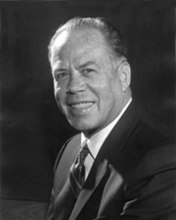| 86th United States Congress | |
|---|---|
85th ← → 87th | |
 United States Capitol (1956) | |
January 3, 1959 – January 3, 1961 | |
| Members | 98–100 senators 436–437 representatives |
| Senate majority | Democratic |
| Senate President | Richard Nixon (R) |
| House majority | Democratic |
| House Speaker | Sam Rayburn (D) |
| Sessions | |
| 1st: January 7, 1959 – September 15, 1959 2nd: January 6, 1960 – September 1, 1960 | |
The 86th United States Congress was a meeting of the legislative branch of the United States federal government, composed of the United States Senate and the United States House of Representatives. It met in Washington, D.C. from January 3, 1959, to January 3, 1961, during the last two years of the presidency of Dwight D. Eisenhower.
Contents
- Major events
- Major legislation
- Constitutional amendments
- Treaties
- States admitted
- Party summary
- Senate
- House of Representatives
- Leadership
- Senate 2
- House of Representatives 2
- Caucuses
- Members
- Senate 3
- House of Representatives 3
- Changes in membership
- Senate 4
- House of Representatives 4
- Committees
- Senate 5
- House of Representatives 5
- Joint committees
- Employees
- Legislative branch agency directors
- Senate 6
- House of Representatives 6
- See also
- Notes
- References
The apportionment of seats in the House of Representatives was based on the 1950 United States census until Alaska and Hawaii were admitted as states in 1959. Then, the membership of the House temporarily increased to 437 (seating one member from each of those newly admitted states and leaving the apportionment of the other 435 seats unchanged); it would remain at 437 until reapportionment resulting from the 1960 census.
The Democrats maintained full control of Congress, with greatly increased majorities in both chambers.














